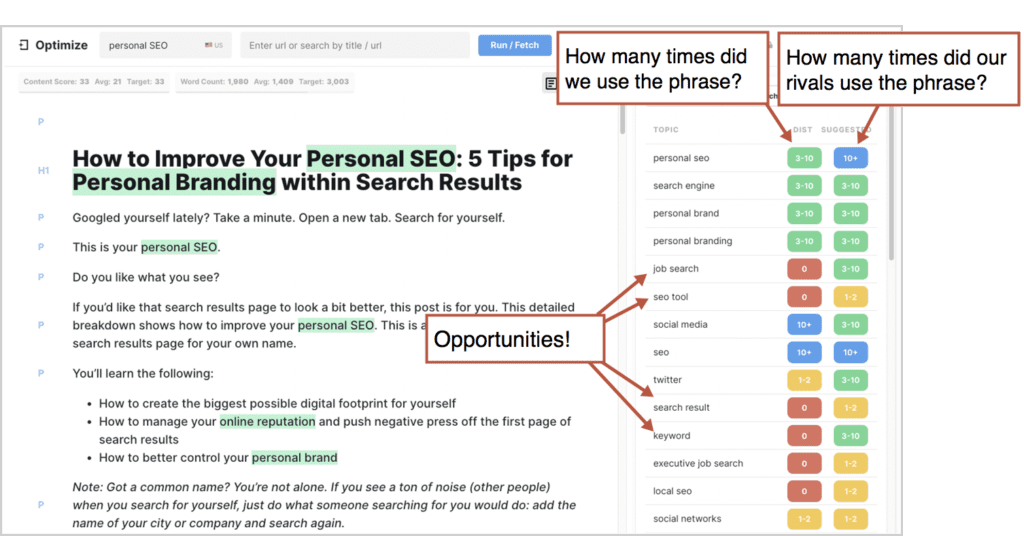From first inspiration to the final draft, this is the process for content creation. It’s a lot of thinking and planning, outreach and research, writing and editing.
We laid out all the steps in order, with all of the little decisions involved, into a single flowchart.
This diagram reflects our content strategy here at Orbit. Yours may be different. But browsing through this single, simple graphic may remind you of tactics that might work for you if you aren’t doing them already.
Here it is, for all of our readers and subscribers. Detailed notes, links to resources and input from experts are included below.
Enjoy!
-Andy and Amanda

You can see that our process includes updating past content, original research, keyphrase research, visuals and collaboration. But we don’t do everything every time.
1. Inspiration
This comes from all directions, from content audits and bike rides. Every topic must fit within your content strategy, but beyond that, it’s all fair game.
Some sources are better than others. The best are focused on the audience and often come directly from conversations and meetings.
Answers to questions your clients and customers are asking you
- An original take on a topic your audience is talking about
- Analytics-driven review of what your audience is engaging with
If the well is dry, here are our best tips for finding blog topics.
2. Consider rewriting an old article
There’s often greater glory in rewriting something old, rather than writing something new. Older content often sits on URLs with strong, unrealized benefits:
- They may already rank, but not yet rank high
- The research and writing process has a huge head start
- You already may have feedback on the topic from your readers
Rewrite an old post that needs love, following the process here. Once done, you’ll re-launch it just as if it was new. Send it as a newsletter and put it back on top of the blog.
The key is to not change the URL. If the URL has been linked to by other websites, you can leverage that authority and target more competitive phrases.
Once we learned the power of updating old content, it became central to our content strategy. Here you can see the entire history of my own writing and the changes over the years:
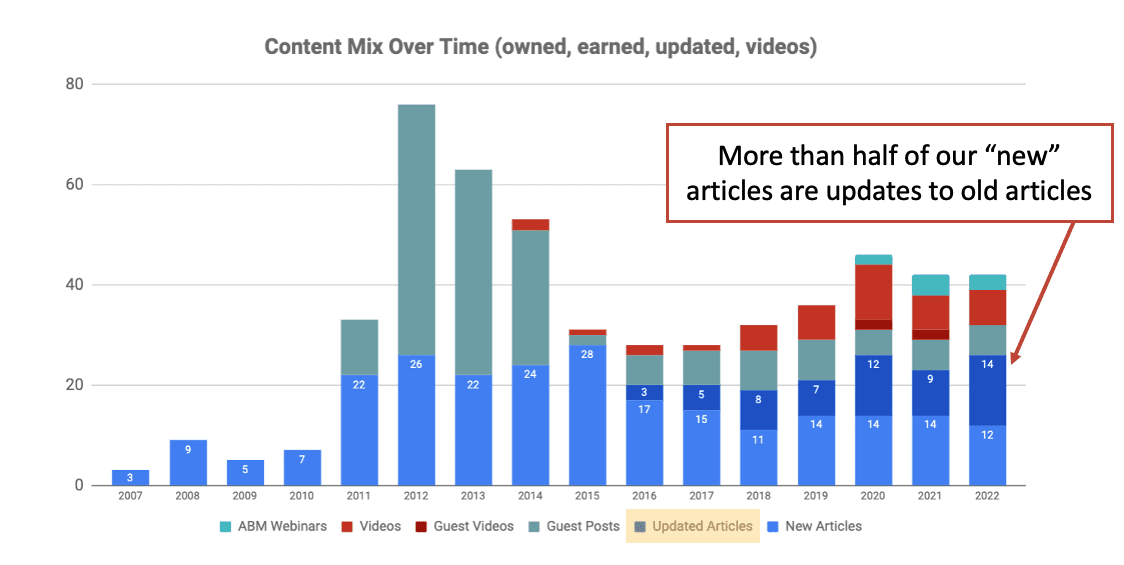
 |
Alina Petrova, Semrush“When it comes to developing an editorial plan, the first impulse might be to create new content. However, updating or repurposing an existing copy can help you achieve your goals by spending less time and resources on content creation. This approach also has SEO benefits, as an updated page takes less time to rank higher than a new piece of content created from scratch. Here are some simple steps that you can include in your content audit workflow:
|
3. Socialize the topic with your network
What do people think about this topic? Is this likely to trigger discussion?
Drop a relevant question into a social stream and see what happens. Within a few hours, you’ll know if it’s engaging and who is engaging.
This works great if you can find a slightly provocative angle to your topic. This works automatically if the topic is a strongly held opinion, especially if that opinion is contrary to readers’ expectations.
The team at Animalz actually has a process for finding topics that challenge the status quo. They call this content “counter-narrative opinions.”
 |
Ryan Law, Animalz“List as many ‘truisms’ as you’re able—the ‘best practices’ and common assumptions that underpin your industry—and then systematically argue against them. Look for edge cases, flawed logic and real-world experiences that refute each truism, and use your content to challenge the status quo.“ |
You can imagine how effective this can be. And you can test these ideas in advance by simply sharing them on social media.
If it works, you’ll immediately want to start capturing ideas and people to follow up with. Just save the link to the post and the thread. In Twitter, just click the tweet and you’ll land on the URL. In LinkedIn, it’s hiding inside the three dot menu.
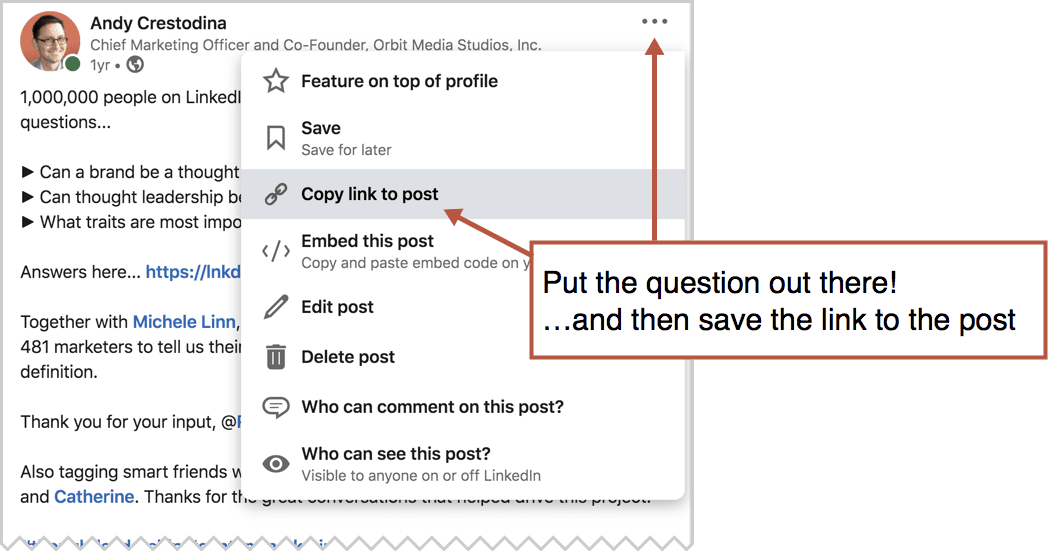
Save this link in the writing template (step 8) so you can find it fast later.
4. Conduct original research
Along with strong opinion, this is the other super-effect content format. Produce a new statistic that supports a frequently made assertion, promote it well and it’s likely to perform well. Specifically, this is the type of content that attracts links.
Here are a few of the more successful examples from this blog, along with the number of linking root domains for each.
- The average website lifespan is 2 years and 7 months (source, 187 links)
- The average bounce rate for website visitors is 62% (source, 35 links)
- The average blog post takes 3 hours and 55 minutes to write (source, 1700 links)
As with strong opinion, it’s especially effective if the research findings are somehow counter-narrative.
That tip is from Michele Linn’s guide for creating original research.
 |
Michele Linn, Mantis Research“How can you ‘bust a myth’ with your research? If you can disprove something that people believe to be true, you’ll attract journalists’ attention and get media mentions.“ |
Research pieces, especially surveys, are a lot more work than a typical post. But they have built-in promotion advantages, especially if the findings are turned into compelling visuals in step 11.
5. Keyphrase Research
There are two main criteria applied when selecting keyword research: demand (search volume) and difficulty (competition). Checking these two things is what keyword research is all about.
First, you’ll need to validate that people are looking for the topic
The SEO tools all estimate search volume, as in, how many people per month search for that phrase. But it’s NOT a number to obsess over. It’s usually a big underestimate of the traffic you might generate.
Search volume reports on the “exact match” demand for the phrase. But content never ranks for just one phrase. If you rank high for one thing, you likely rank for hundreds of other closely related phrases.
- Does Google suggest the phrase when you begin typing a query?
- Does Google Trends show some demand relative to other phrases?
Just do your best to confirm that there is some interest in the topic and move on.
Next, you’ll need to check the difficulty to see if you have any chance of ranking
SEO tools are necessary for this one. They’ll show you the general authority levels of the other pages that rank for the phrase. Average those together and you get a kind of difficulty score for the phrase. This IS a number to obsess over because it’s useless to target a phrase that’s out of reach.
Your level of authority needs to be within the range of the other pages that rank or you are not likely to ever win this fight. At least not on your own website. You can always pitch it as a guest post to a higher-Authority site. The best bloggers don’t just write for their own website.
This video shows the process for keyphrase research:
6. You are writing a search-optimized article
It’s a topic that someone is looking for and it’s a phrase that’s within reach relative to our authority.
Your job is to make a sincere attempt at creating one of the 10 best pages on the internet for our topic and be deserving of a page one ranking.
To do this, you’ll be going deep into the subject.
- We’ll touch on the subtopics.
- We’ll answer all of the most important related questions.
- We’ll back up our claims with evidence.
- We’ll include the voices of relevant experts.
It’s probably going to be a big one. But don’t bother counting words. The writing will be concise, but detailed.
Naturally, we’ll need to indicate relevance for the topic as we go. So we’ll follow SEO best practices and use the primary, target keyphrase in the title tag, <h1> header and body text. But we’re obsessed with quality, not keyword frequency.
This article shows you the step-by-step process for writing high ranking blog posts.
7. You are not writing a search-optimized article
This is one of the simplest ways to understand SEO:
- Every keyphrase is a competition.
- Every page is a competitor.
If your page has no chance of winning the competition (insufficient authority) or if the topic isn’t something people are searching for (announcements, opinion) then quit worrying about SEO.
You are free! Free to write without any consideration for search. Forget keyphrases entirely. There’s no such thing as “a little bit optimized.”
There’s more to life than search. You can promote the article through email, social, outreach, influencers or personally send it directly to people who need it the most. If it’s a great article, it will travel through word of mouth.
8. Setting the structure
Starting with a template is better than starting with a blank document. It will force you to plan for (or at least consider) the various content promotion channels.
Driving traffic can’t just be an afterthought. An article is built to perform in a channel or it isn’t. We need to create it with content promotion in mind.
If you don’t have a template, you are welcome to steal ours. It’s a Google Doc. Copy it, adapt it, make it your own.
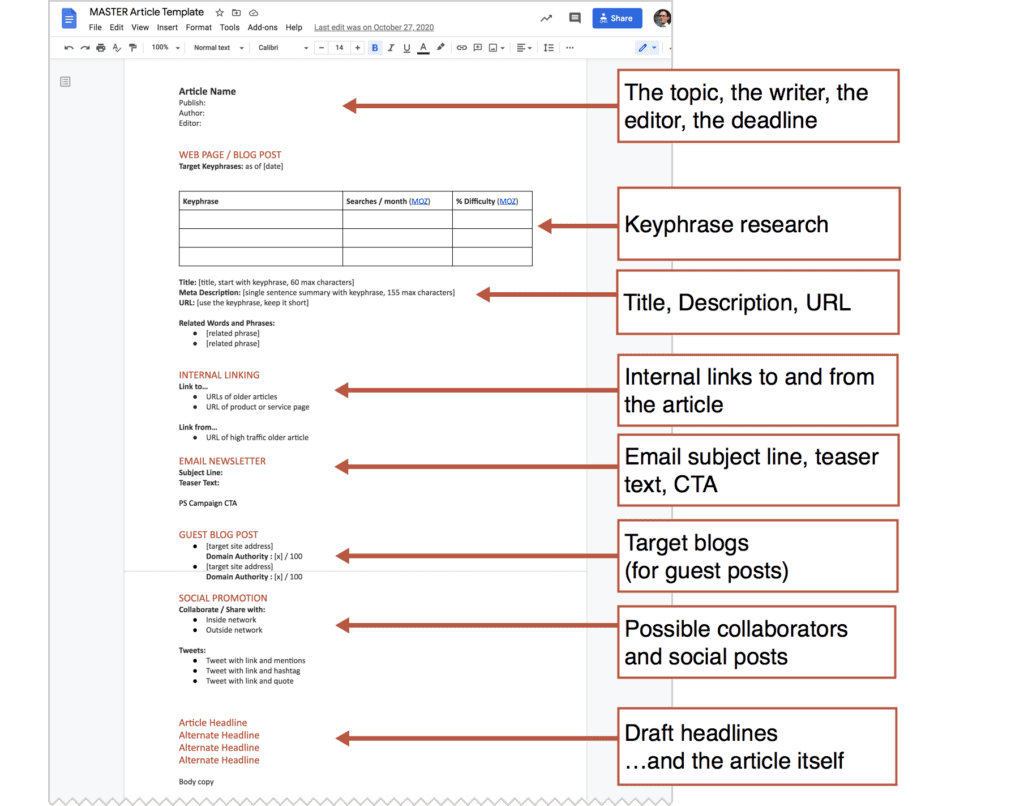
So open up your master content template, copy it and start dropping in your notes. Add links to related articles. Add examples.
Some of these notes will evolve into sections. Others will be discarded.
9. Begin writing
You’re ready. It’s that time and place where you’re the most productive. You’ve turned off notifications and closed all irrelevant browser tabs. Your deep work mix is playing through your noise canceling headphones (here’s mine). It’s time.
- Write the single sentence summary of the article.
- Expand that into the one-paragraph version of the article.
- Write the outline
- Write the part that got you excited in the first place
You might get stuck. You might abandon this idea. That’s fine. But save this doc in your list of partially written articles. You may come back to it one day. And if you ever get ideas or find examples that are related to the topic, just pop open the doc and drop them in.
Eventually, you’ll have a list of dozens of articles, slowly growing over time.
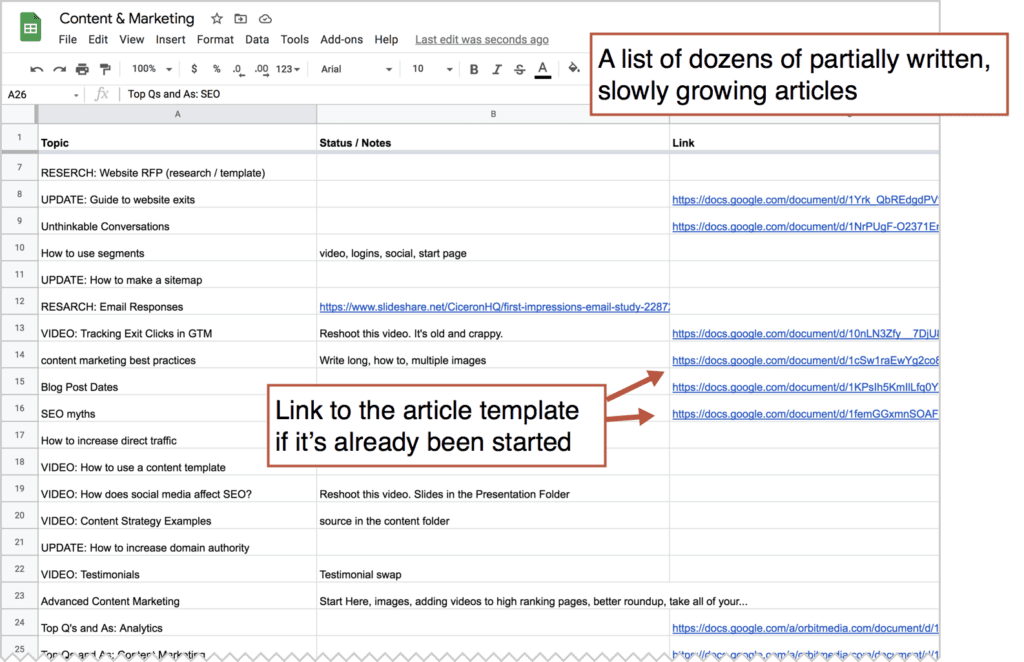
10. Add lots of formatting
Heed the words of the copywriting legend:
“Great copy is never written. It’s assembled.” – Eugene Schwartz
As writers, we choose words for readers. As content developers, we create an experience for the visitor. That experience is about words, but also about formatting and flow. It’s more than writing. It’s a visual, sometimes interactive experience.
Build that experience as you write through formatting.
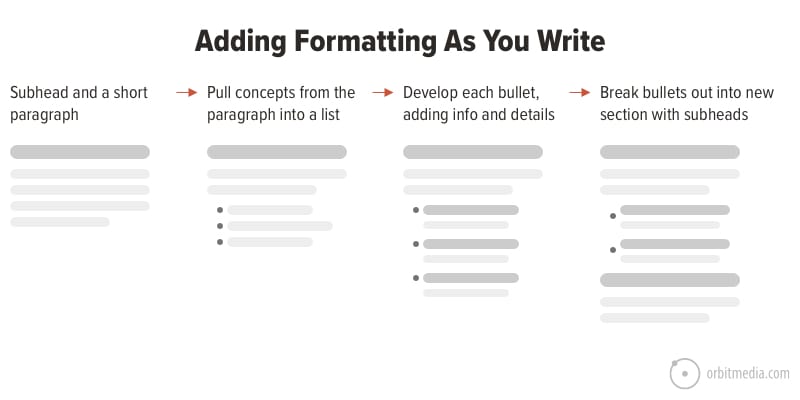
- Subheads
If you resisted writing a clever headline (maybe it didn’t fit with your plan to use a keyphrase?) now is your chance. - Short paragraphs
Avoid writing paragraphs longer than three lines. This creates whitespace, which visitors’ eyes love. - Bullet lists
If a paragraph has a list of three or more items, break them out into bullets. - Numbered lists
As above, but better. Numbered lists create the opportunity to add numerals to your headlines when you get to step 15. - Bolding and Italics
They call attention to key points but don’t overuse them. - Internal links
They are visually prominent, therefore they affect the flow of the eyes. Just look at how prominent an internal link can be! So don’t overdo it.
The difference is huge.
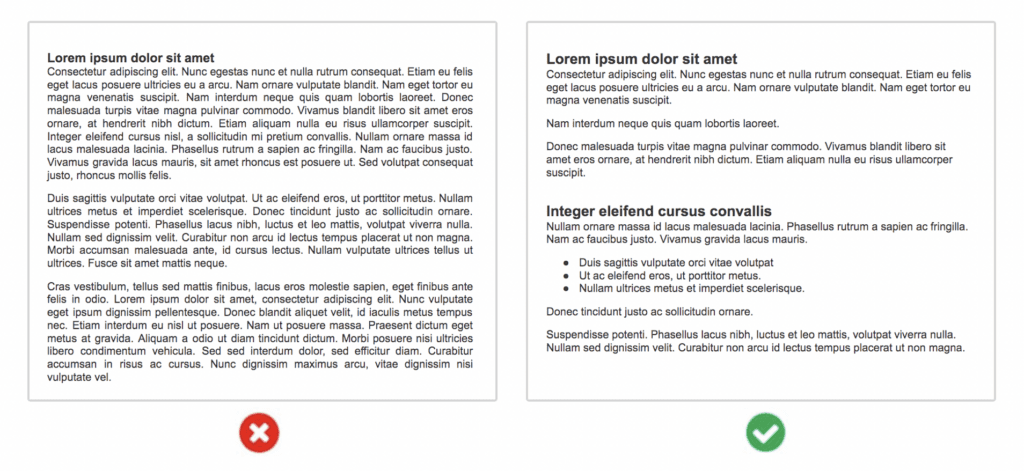
11. Never miss the chance to add a visual
What’s even more important than formatting? The visuals.
Just before your reader arrived, they were in a place with dozens of other options. The search engine, social stream or email inbox was filled with interesting things to read. And the back button is right there.
If you make your visitor slog through long paragraphs of dense text, they’re likely to leave.
If you give your readers something of visual interest at every scroll depth, they’re likely to stay.
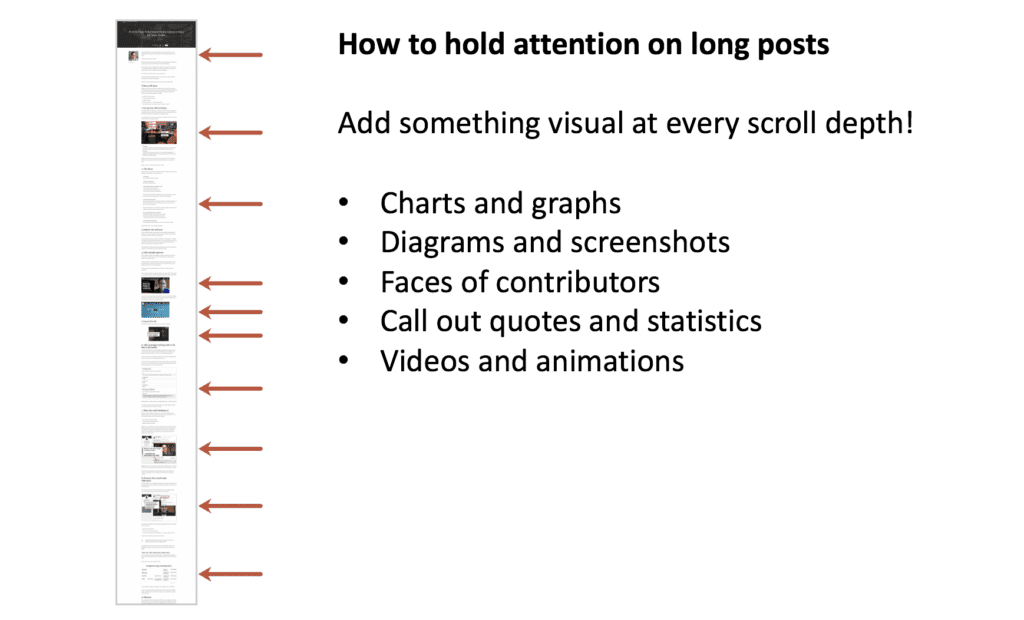
The ideal images support the message of the text. They add value. Charts and diagrams are the best examples, but there are all kinds of blog images that can help.
12. Reach out to a few experts for contributor quotes
Beyond images, contributor quotes are a way to sneak in another visual. And not just any visual. A face! And faces are magnetic, always near the top of the visual hierarchy.
Supper time!

Source: Tobii
But a handsome headshot isn’t the main reason to add a contributor quote. There are better reasons.
- Insights. Improves the quality of the article
- Credibility. Adds expertise, authority and trust to the piece (E-A-T)
- Traffic. Increases reach on social media (ego bait)
- PR and Networking. The outreach and conversation grow your professional network
- Sales. Gives you a pretext to connect with top prospects and cold leads
This kind of collaborative content marketing could also be considered “organic influencer marketing” because it’s free. It’s often just a matter of extending a few of the conversations you started in step 3.
We include contributor quotes in every single post. Why wouldn’t we?
A journalist would never write an article without a source.
Why do content marketers write articles without contributor quotes?
It’s not difficult. It’s fun. It doesn’t take a lot of work. It’s easy. It really doesn’t take long. In fact, it’s the least time consuming part of the process.
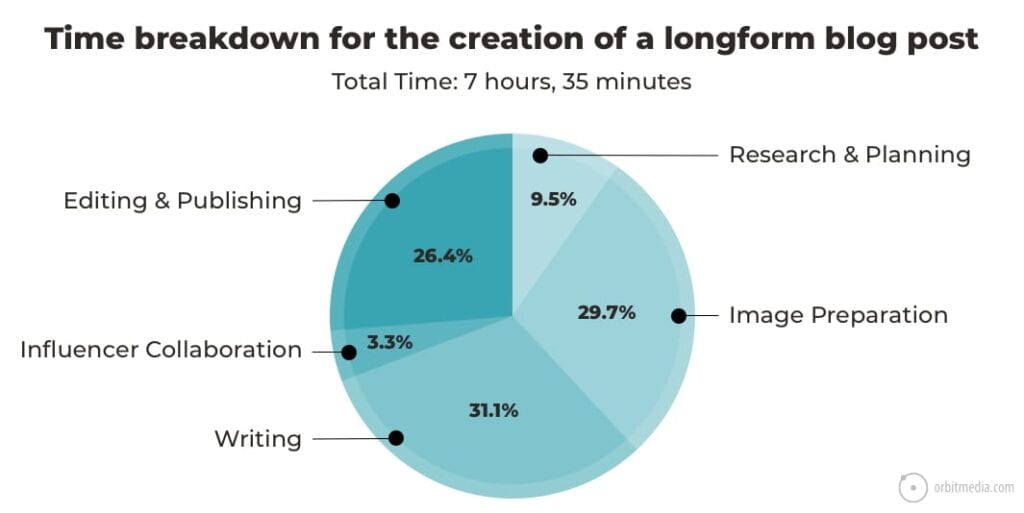
Don’t wait until the last minute to reach out. Give your contributors time to give a thoughtful contribution. When you reach out, let them know the topic, the ideal contribution length and the deadline.
13. Add examples and stories
A lot of content fails because it’s just too common. More of the usual tips and advice. Just another list of typical recommendations. Nothing differentiated. Nothing real.
A few specific, real world examples would save a lot of this content from mediocrity.
- Add a little narrative with characters and conflict, before and after, cases and evidence.
- Add visual examples, showing the concepts in practice, both good and bad.
- Make it personal, injecting the writer’s own experience.
A simple story, true and relevant, will transform our boring list of general advice into a compelling thread, pulling our reader deeper into the message.
Plus, having a few specifics will help you write your headlines later.
How does concrete language make you a better writer?
Our friend and master writing coach Henneke explains here. I just love that article.
14. Strengthen assertions
Here’s another quality check: go back and remove all of that softening language. Cut out the “throat clearing” sentence in the intro. Be direct and concise, even if it feels like you’re overstating things a bit.
Compare the before and after:
This may have been the most significant finding from the research.
This was the biggest insight from the survey.
It’s generally considered best practice to have each article reviewed by an editor.
It’s a mistake to not use an editor.
It’s common for experts to recommend that language be direct and assertive.
Get to the point.
Best Practices to Consider: 15 Changes That Might Improve Your Website
Fix Your Funnel: 15 Things to Remove From Your Site Immediately.
That last example was a headline from this blog. Did it work? Yes, very well! That post was shared nearly 5000 times. That’s 100x our typical results. The boost to the tone likely explains the boost in engagement on social media.
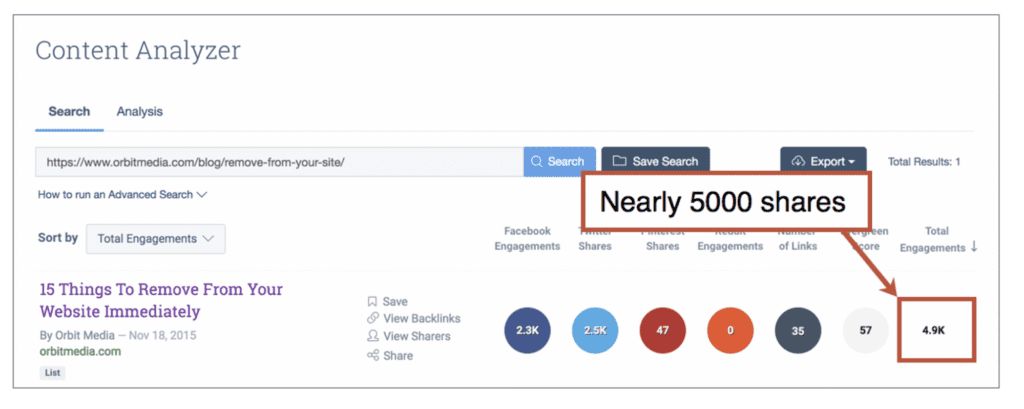
Your writing shouldn’t taste like water. And because it comes from you, it should sound like you.
 |
Mark Schaefer, author of eight books including his latest, Cumulative Advantage“Here is the easiest content creation tip ever: read your copy aloud. If you stumble over words, change them. By reading aloud, you’re sure to be creating in a natural human voice!“ |
15. Optimize for search and indicate relevance
If the outcome of the keyword research led you through step 6, you’re writing a search optimized article. You’ve included the primary target keyphrase in the title and header. The text itself covers the topic in detail.
Now it’s time to confirm that you’ve indicated relevance for the broader topic, not just the narrow keyphrase. It’s time for a little semantic SEO.
Find the semantically related phrases. They’re hiding in the usual places: Google Suggest, “People also ask,” related searches, Quora and rival’s rankings. Make a list and then work them into the article, adding depth and detail as you go.
Shortcut! MarketMuse (paid tool, but very reasonable) does many things but is known for the Optimizer. It’s a clever AI that compares your new page to the other pages that rank for the phrase.
16. Write the draft headlines
The best content marketers write many draft headlines before picking the winner. They also don’t use the same headline for everything.
Headlines should be adapted for the location: title tag, header, subject line, social posts, infographic header, video title. Each element has its own opportunities, captured in different ways. Here’s a guide:
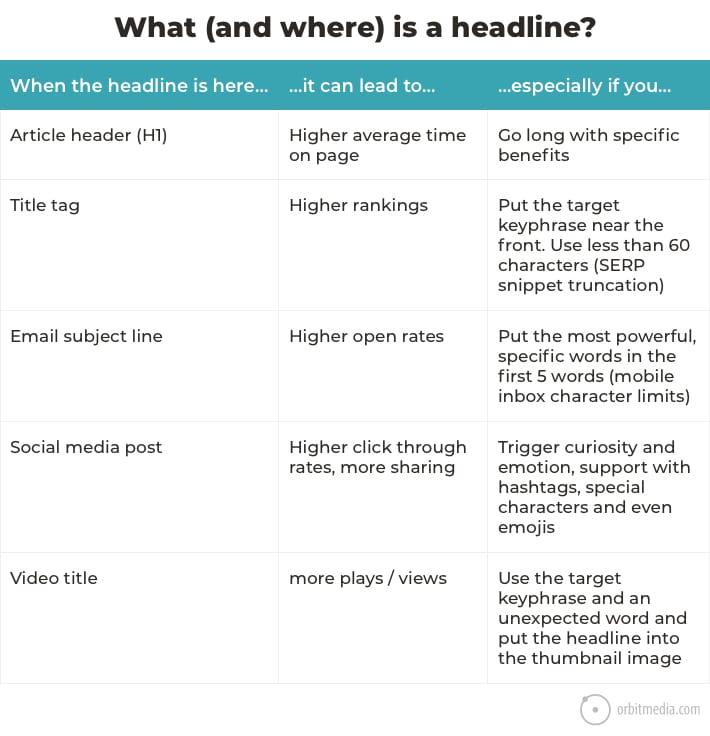
Source: How to Write Truly Great Headlines
The best headline writers create something memorable. Whenever possible they give their idea a name, as in Mark Schaefer’s “Content Shock,” Doug Kessler’s “Insane Honestly” or Brian Dean’s “Skyscraper Technique.”
Ryan Law calls these “Coined Concepts,” a pithy catchphrase that encapsulates the article’s ideas and arguments.
“Coined concepts can be borrowed from adjacent fields, inspired by frameworks and models from science, academia, business, and entertainment. Once-popular concepts can be resurrected and given a new lease of life. If you’re feeling creative, you can even create a brand-new concept from scratch.” – Ryan Law, Animalz
17. Plan the promotion
You made it! You’ve created an article that’s ready for promotion. The process getting here pushed you to build in many of the elements that correlate with success.
Social Media
- In step 3 you shared the idea with your network. Once it’s live you can let them know by tagging them when you share it.
- In step 11 you made visuals
- In step 12 you added quotes from contributors
Search Engine Optimization
- In step 2 …recycled URL
- In steps 5 and 6 …keyphrase research
Now you need to get the elements of the newsletter ready. The subject line will be one of the draft headlines (no keywords required) and the teaser text is often an adapted version of the intro.
All other rejected headlines can be used as social media posts.
Beyond the three main channels for promotion (social, search, email) there are dozens of other ways you can promote your content. Ultimately, success depends as much on promotion as the article itself.
The best article doesn’t win. The best promoted article wins.
Structure, Forethought and Discipline
Let’s give the last word to Mark Schaefer, an expert content marketer and prolific writer. Combine his advice about mindset with the tactical recommendations above and you should be all set.
 |
Mark Schaefer, speaker and best-selling author BusinessGrow.com“Content creation is a matter of four disciplines. First, you have to have the discipline to be aware of the story ideas bombarding you every day. View your life as possible content that is unfolding. Second, you must have the discipline to record those ideas immediately or you’ll lose them! Next, you need to block out quiet, undisturbed time to create. Actually schedule time, just as you would schedule a meeting or a date. Last, it’s best to find a way to relax when creating content. Creating content under pressure is never a path to optimal output!” |

